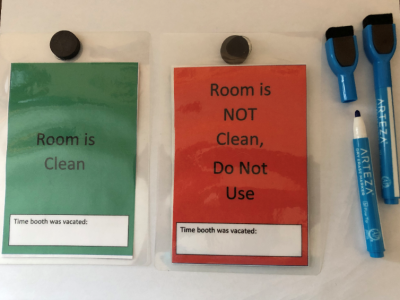All recommendations are made with the best current information and in the context of a multifaceted safety program. When a variety of safety measures are put in place, our chance of protecting our patients and colleagues increases.
All safety recommendations assume that
- Staff and patients are screened (with a questionnaire at a minimum) and individuals who do not pass the screening do not report to the clinic.
- All individuals use excellent hygiene which includes frequent hand washing (while refraining from touching your face/eyes/nose/mouth.
- All individuals maintain social distancing as much as possible in the context of a clinic appointment.
- All individuals wear masks.
With these safety precautions in place, workplace surfaces need to be cleaned thoroughly between patient encounters. Specific to audiologists, we must consider safety related to the test booth environment.
All surfaces in the booth and equipment that touches the audiologist or patient should be wiped down with a disinfectant similar to cleaning used in treatment rooms. This includes wiping the surfaces and equipment in the audiologist test area of the booth as well.
Booth manufacturers are recommending leaving the booth empty with the door closed for a period between patients to allow for one full cycle of air exchange in the booth. This assumes the booth is attached to the HVAC system of the building (the preferred set-up).
Typical medium-sized booths in adult clinics (just large enough for sound field testing) will exchange air in about 10 minutes with the door closed (closing the door shortens the exchange time).
A large pediatric test both will take about 15 minutes to fully exchange the air with the door closed and “phone booth” sized booths will fully exchange air in about two minutes.
If you would like to know the exact time for a full cycle of air exchange, contact the person responsible for the HVAC in your building and they can calculate this for you based on the exact dimensions of the room and power of the HVAC system.
They can provide this information for you regarding your treatment rooms as well based on the room dimensions. If your booth is not attached to the HVAC system and uses fans, then the time for complete air exchange will be longer. This would be a good time to request that the booth be attached to the HVAC system and something to keep in mind with any new construction.
 If you are in a clinic with multiple booths and multiple clinicians, you may want to consider having a magnetic sign with red on one side (marked Room is NOT Clean, Do Not Use) and green on the other (Room is Clean).
If you are in a clinic with multiple booths and multiple clinicians, you may want to consider having a magnetic sign with red on one side (marked Room is NOT Clean, Do Not Use) and green on the other (Room is Clean).
This is helpful if you have the situation where someone might complete a hearing test and move the patient over to another room and perhaps speak with them briefly without being able to clean the room.
This warns the next audiologist that the booth area needs to be cleaned before the next use. You can use a dry erase pen (with magnet and eraser attached) to indicate the time the booth was vacated (with door closed).
You can get dry erase pens with a magnet so they will stick to the booth near the green/red sign. This will allow the next audiologist to know if the allotted time has passed for one full cycle of air exchange.
Related Posts
Havana Syndrome Sparks Debate Among Experts
Audio-vestibular symptoms are gaining national attention and sparking debate amongst professionals and the public. A CBS 60 Minute report on Sunday, March 31, revisited Havana…
ADHD in Children in the United States
Audiologists sometimes see patients who also present with a diagnosis of attention-deficit/hyperactivity disorder (ADHD). Reuben and Elgaddal (2024) reported the percentage of children in the…
Remote Diagnostic Hearing Assessment in School-Entry-Aged Children
Even before the COVID-19 pandemic, telehealth and remote audiology visits were increasing in frequency and popularity. D’Onofrio and Zeng (2021) reported that telemedicine was adapted…


